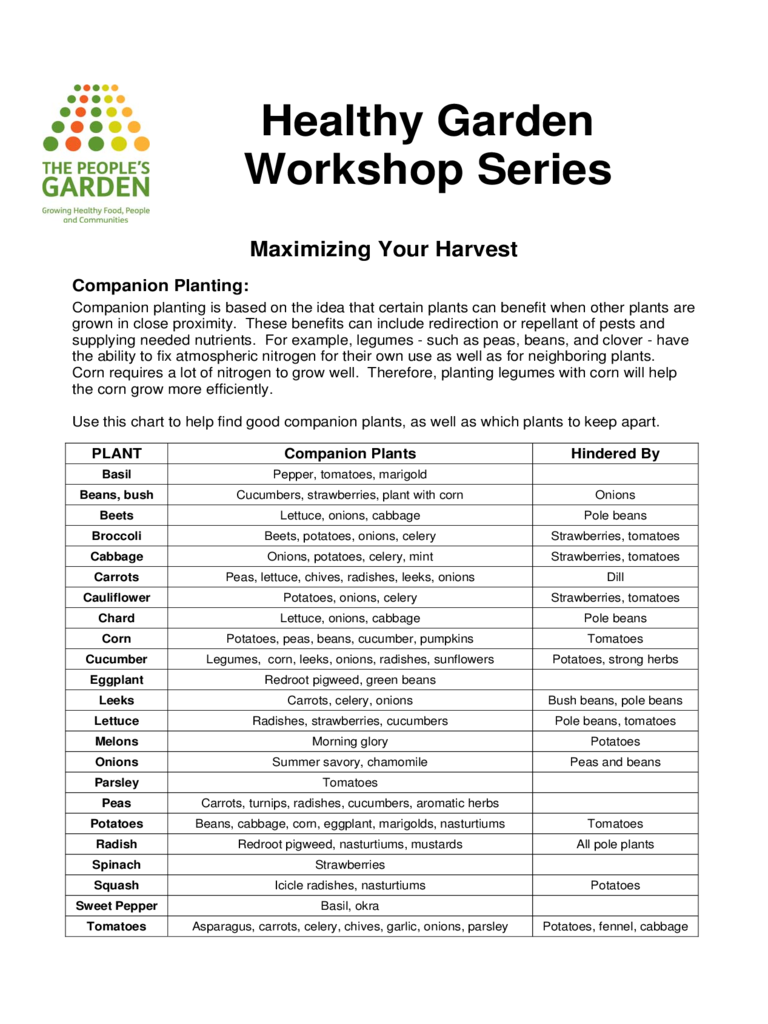Fillable Printable Healthy Gardening Companion Planting Chart
Fillable Printable Healthy Gardening Companion Planting Chart

Healthy Gardening Companion Planting Chart

Healthy Garden
Workshop Series
Maximizing Your Harvest
Companion Planting:
Companion planting is based on the idea that certain plants can benefit when other plants are
grown in close proximity. These benefits can include redirectio n or repellant of pests and
supplying needed nutrients. For example, legumes - such as peas, beans, and clover - have
the ability to fix atmospheric nitrogen for their own use as well as for neighboring plants.
Corn requires a lot of nitrogen to grow well. Therefore, planting legumes with corn will help
the corn grow more efficiently.
Use this chart to help find good companion plants, as well as which plants to keep apart.
PLANT Companion Plants Hindered By
Basil
Pepper, tomatoes, marigol d
Beans, bush
Cucumbers, stra wberries, plant with corn Onions
Beets
Lettuce, onions, ca bbage Pole beans
Broccoli
Beets, potatoes, onions, celery Strawberries, tomatoes
Cabbage
Onions, potatoes, celery, mint Strawberries, tomatoes
Carrots
Peas, lettuce, chives, radishes, leeks, onions Dill
Cauliflower
Potatoes, onions, celery Strawberries, tomatoes
Chard
Lettuce, onions, ca bbage Pole beans
Corn
Potatoes, peas, beans, cucumber, pumpkins Tomatoes
Cucumber
Legumes, corn, leeks, oni ons, radishes, sunflowers Potatoes, strong herbs
Eggplant
Redroot pigweed, green beans
Leeks
Carrots, celery, onions Bush beans, pole be ans
Lettuce
Radishes, strawb erries, cucumbers Pole beans, tomatoes
Melons
Morning glory Potatoes
Onions
Summer savory, chamomile Peas and beans
Parsley
Tomatoes
Peas
Carrots, turnips, radishes, cucumb ers, aromatic herbs
Potatoes
Beans, cabbage, corn, eggplant, marigolds, nasturtiums Tomatoes
Radish
Redroot pigweed, na sturtiums, mustards All pole plants
Spinach
Strawberries
Squash
Icicle radishes, nasturtiums Potatoes
Sweet Pepper
Basil, okra
Tomatoes
Asparagu s, carrots, celery, chiv es, garlic, onions, parsley Potatoes, fennel, cabbage

Harvesting Your Produce:
Knowing when and how to harvest your produce is an important part of gardening. The
closer you can pick the produce to when it will be eaten, the better. Some squash, beans,
and lettuce continue to grow more produce when they are picked often. Below are some tips
to help harvest your plants for maximum flavor and enjoyment.
Asparagus:
• Harvest when spea rs reach 6 to 8 inches tall by clippin g stalks close to the soil
Broccoli:
• Pick broccoli when heads form into tight, firm clusters
• Cut off the head with 6 inches of stem att ached
• Side heads will form after first head is cut.
Chard:
• Cut the outer leaves clo se to ground when 8-10" tall
• Make sure to leave 4-6 le aves on the plant so it can continue to grow
Eggplant:
• Ripe when sh iny and 6-8 inches long
• Clip the stem several inches above the vegetable with scissors or a sharp knife
Herbs:
• Use immediately or freeze i n an ice cube tray with wat er or a vacuum sealed bag
• For leafy herbs, pick the leaves and chop before use
• For seedy herbs, break off a small b ran ch of the herb and swipe off the herbs
• Pick any flowers immediately or the herb may become bitter
Lettuce:
• Leaf lettuce will continue to grow if picked often and properly
• For leaves, cut outer leaf early at the base of the leaves, ~ 2 inches up from the soil
• For heads, ready when firm and tight, cut at the base where the plant meets the soil
Melons:
• Pick when vine starts to dry out
• Clip the vine just above the fruit with scissors or a sharp knife
Peppers:
• Harvest Jalapeno peppers at 3-4 inche s, green p eppers at the size of a fist
• Clip the stem just above the pepper with scissors or a sharp knife
Peas:
• Harvest when the pod is green an d full but still tender, pods are usually ready to be harvested a week
after the plant flowers
• Clip the stem just above the pod with sci ssors or a sharp knife
Squash and Cucumbers:
• Pick often and more will grow
• Pick when ~ 6 inches for a more tender vegetable and better flavor
• Clip the vine/stem just abo ve the fruit with scissors or a sharp knife
Tomatoes:
• When red, clip the stem just above the tomato with scissors or a sharp knife
United States Dep artment of Agriculture



